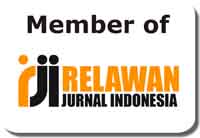Mediating Quizzes as Assessment Tool through WhatsApp Auto-response in ELT Online Class
Abstract
Keywords
Full Text:
PDFReferences
Ahmed, S. T. S. (2019). Chat and Learn: Effectiveness of Using WhatsApp as a Pedagogical Tool to Enhance EFL Learners Reading and Writing Skills. International Journal of English Language and Literature Studies, 8(2), 61–68. https://doi.org/10.18488/journal.23.2019.82.61.68
Allen, M. (2017). Frame Analysis. In The SAGE Encyclopedia of Communication Research Methods. SAGE Publications, Inc. https://doi.org/10.4135/9781483381411.n210
Alshammari, R., Parkes, M., & Adlington, R. (2017). Using WhatsApp in EFL Instruction with Saudi Arabian University Students. Arab World English Journal, 8(4), 68–84. https://doi.org/10.24093/awej/vol8no4.5
Alsied, S. M. (2019). The Role of Mobile Phones as Effective Tools for Language Learning by Libyan EFL Learners. JEELS (Journal of English Education and Linguistics Studies), 6(2), 135–163. https://doi.org/10.30762/jeels.v6i2.1234
Alzahrani, H. (2015). Examining the Effectiveness of Utilizing Mobile Technology in Vocabulary Development for Language Learners. Arab World English Journal, 6(3), 108–119. https://doi.org/10.24093/awej/vol6no3.7
Andújar-Vaca, A., & Cruz-Martínez, M.-S. (2017). Mobile instant messaging: Whatsapp and its potential to develop oral skills. Comunicar, 25(50), 43–52. https://doi.org/10.3916/C50-2017-04
Barhoumi, C. (2015). The Effectiveness of WhatsApp Mobile Learning Activities Guided by Activity Theory on Students’ Knowledge Management. Contemporary Educational Technology, 6(3), 221–238. https://doi.org/10.30935/cedtech/6151
Bouhnik, D., & Deshen, M. (2014). WhatsApp Goes to School: Mobile Instant Messaging between Teachers and Students. Journal of Information Technology Education: Research, 13, 217–231. https://doi.org/10.28945/2051
Bowen, G. A. (2009). Document Analysis as a Qualitative Research Method. Qualitative Research Journal, 9(2), 27–40. https://doi.org/10.3316/QRJ0902027
Brandtzaeg, P. B., & Følstad, A. (2017). Why People Use Chatbots. In Kompatsiaris I. et al. (eds) Internet Science. INSCI 2017 (Lecture No, pp. 377–392). Springer, Cham. https://doi.org/10.1007/978-3-319-70284-1_30
Cetinkaya, L. (2017). The Impact of Whatsapp Use on Success in Education Process. The International Review of Research in Open and Distributed Learning, 18(7), 59–72. https://doi.org/10.19173/irrodl.v18i7.3279
Colace, F., Santo, M. De, Lombardi, M., Pascale, F., Pietrosanto, A., & Lemma, S. (2018). Chatbot for E-Learning: A Case of Study. International Journal of Mechanical Engineering and Robotics Research, 7(5), 528–533. https://doi.org/10.18178/ijmerr.7.5.528-533
Dewi, S. R. (2019). Utilizing WhatsApp Application for Teaching Integrated English (A Case Study at University of Technology Yogyakarta). Jurnal Ilmiah Kependidikan, 9(2), 164–171. http://jurnal.umk.ac.id/index.php/RE
Fei, Y., & Petrina, S. (2013). Using Learning Analytics to Understand the Design of an Intelligent Language Tutor – Chatbot Lucy. International Journal of Advanced Computer Science and Applications, 4(11), 124–131. https://doi.org/10.14569/IJACSA.2013.041117
Fitriani, V. F. (2020). Portraying Efl Students ’ Learning S Tyles in Utilizing Mobile-Assisted Language Learning : How To Be a Good Language Learner ? Journal of Teaching & Learning in Multicultural Context, 4(1), 34–45.
Gautam, A. (2014). Mobile Learning ; An Effective Way of Teaching and Learning English Language. International Journal on Studies in English Language and Literature (IJSELL), 2(5), 50–52.
Gon, S., & Rawekar, A. (2017). Effectivity of E-Learning through Whatsapp as a Teaching Learning Tool. MVP Journal of Medical Sciences, 4(1), 19. https://doi.org/10.18311/mvpjms/0/v0/i0/8454
Griffee, D. T. (2012). An Introduction to Second Language Research Methods: Design and Data. In TESL-EJ Publications, Berkeley (Vol. 15, Issue March, p. 213). ESL-EJ Publications. https://doi.org/10.1017/CBO9781107415324.004
Hamad, M. M. (2017). Using WhatsApp to Enhance Students’ Learning of English Language “Experience to Share.” Higher Education Studies, 7(4), 74. https://doi.org/10.5539/hes.v7n4p74
Hashim, W., & Hashim, H. A. (2015). Selection of Appropriate Media and Technology for Distance Education. International Journal of Science and Research (IJSR), 4(11), 1209–1216. https://doi.org/10.21275/v4i11.NOV151151
Hazaea, A. N., & Alzubi, A. A. (2016). The Effectiveness of Using Mobile on EFL Learners’ Reading Practices in Najran University. English Language Teaching, 9(5), 8. https://doi.org/10.5539/elt.v9n5p8
Ifewulu, H. A., & Goeman, K. (2017). Selecting Media for Effective Learning in Online and Blended Courses: A Review Study. Journal of Educational Multimedia and Hypermedia, 26(1), 29–59.
Jain, M., Kumar, P., Kota, R., & Patel, S. N. (2018). Evaluating and Informing the Design of Chatbots. Proceedings of the 2018 on Designing Interactive Systems Conference 2018 - DIS ’18, 895–906. https://doi.org/10.1145/3196709.3196735
Jati, A. G. (2018). The Use of Smartphone Applications in English Language Teaching and Learning. Jurnal Sosioteknologi, 17(1), 144–153. https://doi.org/10.5614/sostek.itbj.2018.17.1.14
Justina, M. (2016). Use of Whatsapp to Enhance Reading and Writing Skills at Undergraduate College Level. Language in India, 16(11), 47–60. http://www.languageinindia.com/nov2016/mariawhatsappfinal.pdf
Kacetl, J., & Klímová, B. (2019). Use of Smartphone Applications in English Language Learning—A Challenge for Foreign Language Education. Education Sciences, 9(3), 179. https://doi.org/10.3390/educsci9030179
Kartal, G. (2019). What’s up with WhatsApp? A Critical Analysis of Mobile Instant Messaging Research in Language Learning. International Journal of Contemporary Educational Research, 6(2), 253–265. https://doi.org/10.33200/ijcer.599138
Kheryadi, K. (2018). The Implementation of “WHATSAPP” as a Media of English Language Teaching. Loquen: English Studies Journal, 10(2), 1. https://doi.org/10.32678/loquen.v10i2.685
La Hanisi, A., Risdiany, R., Dwi Utami, Y., & Sulisworo, D. (2018). The use of WhatsApp in collaborative learning to improve English teaching and learning process. International Journal of Research Studies in Educational Technology, 7(1), 29–35. https://doi.org/10.5861/ijrset.2018.3004
Lenhart, A., Madden, M., Smith, A., & Macgill, A. R. (2007). Teens and social media: An overview. In Pew Internet and American Life Project.
Lyddon, P. A. (2016). Mobile-assisted language learning and language learner autonomy. In CALL communities and culture – short papers from EUROCALL 2016 (pp. 302–306). https://doi.org/10.14705/rpnet.2016.eurocall2016.579
Mariko, I. (2015). A Window which lets in Light: The Importance of Selecting and Preparing Instructional Media in Tertiary Education. International Journal of Humanities and Social Science, 5(2), 245–247. http://www.ijhssnet.com/journals/Vol_5_No_2_February_2015/27.pdf
Mbukusa, N. R. (2018). Perceptions of students’ on the Use of WhatsApp in Teaching Methods of English as Second Language at the University of Namibia. Journal of Curriculum and Teaching, 7(2), 112. https://doi.org/10.5430/jct.v7n2p112
Miles, M.B & Huberman, A. . (1994). An expanded sourcebook: Qualitative data analysis (2nd Edition). In Sage Publications (2nd ed.). https://doi.org/10.1016/0149-7189(96)88232-2
Minalla, A. A. (2018). The Effect of WhatsApp Chat Group in Enhancing EFL Learners’ Verbal Interaction outside Classroom Contexts. English Language Teaching, 11(3), 1. https://doi.org/10.5539/elt.v11n3p1
Nagender, Y., & Patil, K. H. (2017). Whatsapp Auto Responder Using Natural Language Processing and AI. International Journal of Computer Engineering & Technology (IJCET), 8(5), 15–22. http://www.iaeme.com/ijcet/issues.asp?JType=IJCET&VType=8&IType=5
Nuraeni, C., & Nurmalia, L. (2020). Utilizing WhatsApp Application in English Language Learning Classroom. Metathesis: Journal of English Language, Literature, and Teaching, 4(1), 89. https://doi.org/10.31002/metathesis.v4i1.2289
Palalas, A. (2011). Mobile-assisted language learning: designing for your students. In Second Language Teaching and Learning with Technology: Views of Emergent Researchers (pp. 71–94). Research-publishing.net. https://doi.org/10.14705/rpnet.2011.000007
Persson, V., & Nouri, J. (2018). A Systematic Review of Second Language Learning with Mobile Technologies. International Journal of Emerging Technologies in Learning (IJET), 13(02), 188. https://doi.org/10.3991/ijet.v13i02.8094
Rosenberg, H., & S. C. Asterhan, C. (2018). “WhatsApp, Teacher?” - Student Perspectives on Teacher-Student WhatsApp Interactions in Secondary Schools. Journal of Information Technology Education: Research, 17, 205–226. https://doi.org/10.28945/4081
Salas-Morera, L., Arauzo-Azofra, A., & García-Hernández, L. (2012). Analysis of Online Quizzes as a Teaching and Assessment Tool. Journal of Technology and Science Education, 2(1), 39–45. https://doi.org/10.3926/jotse.30
Smutny, P., & Schreiberova, P. (2020). Chatbots for learning: A review of educational chatbots for the Facebook Messenger. Computers & Education, 151, 103862. https://doi.org/10.1016/j.compedu.2020.103862
Tamayo, P. A., Herrero, A., Martín, J., Navarro, C., & Tránchez, J. M. (2020). Design of a chatbot as a distance learning assistant. Open Praxis, 12(1), 145. https://doi.org/10.5944/openpraxis.12.1.1063
Urien, B., Erro-Garcés, A., & Osca, A. (2019). WhatsApp usefulness as a communication tool in an educational context. Education and Information Technologies, 24(4), 2585–2602. https://doi.org/10.1007/s10639-019-09876-5
W. Mwakapina, J., S. Mhandeni, A., & S. Nyinondi, O. (2016). WhatsApp Mobile Tool in Second Language Learning: Opportunities, Potentials and Challenges in Higher Education Settings in Tanzania. International Journal of English Language Education, 4(2), 70. https://doi.org/10.5296/ijele.v4i2.9711
Wu, Q. (2015). Designing a smartphone app to teach English (L2) vocabulary. Computers & Education, 85, 170–179. https://doi.org/10.1016/j.compedu.2015.02.013
Zumstein, D., & Hundertmark, S. (2017). Chatbots : an interactive technology for personalized communication and transaction. International Journal on www/Internet, 15(1), 96–109.
DOI: http://dx.doi.org/10.31332/lkw.v6i2.2216
Copyright (c) 2020 Agus Husein As Sabiq

This work is licensed under a Creative Commons Attribution-ShareAlike 4.0 International License.
Langkawi: Journal of The Association for Arabic and English indexed by:


















.png)
.png)

.png)
2.png)








